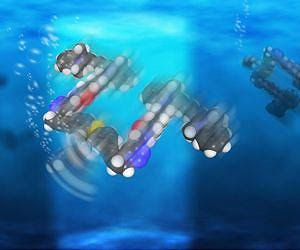 Rice makes light-driven nanosubmarine
Houston TX (SPX) Nov 17, 2015 -
Though they're not quite ready for boarding a la "Fantastic Voyage," nanoscale submarines created at Rice University are proving themselves seaworthy. Each of the single-molecule, 244-atom submersibles built in the Rice lab of chemist James Tour has a motor powered by ultraviolet light. With each full revolution, the motor's tail-like propeller moves the sub forward 18 nanometers.
And with ...
more
Rice makes light-driven nanosubmarine
Houston TX (SPX) Nov 17, 2015 -
Though they're not quite ready for boarding a la "Fantastic Voyage," nanoscale submarines created at Rice University are proving themselves seaworthy. Each of the single-molecule, 244-atom submersibles built in the Rice lab of chemist James Tour has a motor powered by ultraviolet light. With each full revolution, the motor's tail-like propeller moves the sub forward 18 nanometers.
And with ...
more

 S.Africa and China sign nuclear energy cooperation pact
Johannesburg (AFP) Nov 16, 2015 -
Nuclear energy regulators in South Africa and China have signed a technical cooperation agreement as Africa's most industrialised economy presses forward with controversial plans to build eight new nuclear reactors.
The deal, which includes "licensing procedures, vendor inspections, inspector training and joint inspections and technical support", was signed last week in Beijing, South Afric ...
more
S.Africa and China sign nuclear energy cooperation pact
Johannesburg (AFP) Nov 16, 2015 -
Nuclear energy regulators in South Africa and China have signed a technical cooperation agreement as Africa's most industrialised economy presses forward with controversial plans to build eight new nuclear reactors.
The deal, which includes "licensing procedures, vendor inspections, inspector training and joint inspections and technical support", was signed last week in Beijing, South Afric ...
more

 Discovery of classic pi formula a 'cunning piece of magic'
Rochester NY (SPX) Nov 17, 2015 -
While most people associate the mathematical constant p (pi) with arcs and circles, mathematicians are accustomed to seeing it in a variety of fields. But two University of Rochester scientists were still surprised to find it lurking in a quantum mechanics formula for the energy states of the hydrogen atom.
"We didn't just find pi," said Tamar Friedmann, a visiting assistant professor of m ...
more
Discovery of classic pi formula a 'cunning piece of magic'
Rochester NY (SPX) Nov 17, 2015 -
While most people associate the mathematical constant p (pi) with arcs and circles, mathematicians are accustomed to seeing it in a variety of fields. But two University of Rochester scientists were still surprised to find it lurking in a quantum mechanics formula for the energy states of the hydrogen atom.
"We didn't just find pi," said Tamar Friedmann, a visiting assistant professor of m ...
more

 Ultra-thin, tunable, broadband microwave absorber may advance radar cloaking
Washington DC (SPX) Nov 17, 2015 -
Microwave absorbers are a kind of material that can effectively absorb incident microwave energy to make objects invisible to radar; therefore they are commonly used in aircraft cloaking and warship stealth.
Recently, as radar detection devices have been improved to detect the near-meter microwave length regime, scientists are working on high-performance absorbers that can cloak objects i ...
more
Ultra-thin, tunable, broadband microwave absorber may advance radar cloaking
Washington DC (SPX) Nov 17, 2015 -
Microwave absorbers are a kind of material that can effectively absorb incident microwave energy to make objects invisible to radar; therefore they are commonly used in aircraft cloaking and warship stealth.
Recently, as radar detection devices have been improved to detect the near-meter microwave length regime, scientists are working on high-performance absorbers that can cloak objects i ...
more




